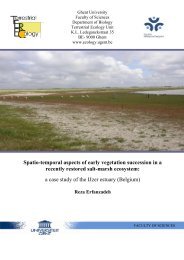PhD Arthur Decae 2010 - Ghent Ecology - Universiteit Gent
PhD Arthur Decae 2010 - Ghent Ecology - Universiteit Gent
PhD Arthur Decae 2010 - Ghent Ecology - Universiteit Gent
You also want an ePaper? Increase the reach of your titles
YUMPU automatically turns print PDFs into web optimized ePapers that Google loves.
TNT-analysis of reduced data-set (64 taxa, 27 characters, appendix Table 6)<br />
Four runs of cladistic analyses (against four different reference groups, see above) on a<br />
reduced data-matrix (Appendix Table 5) using the TNT-program confirmed our MDS results<br />
by showing a basic division of Nemesia in two distinct sub-generic clades (Appendix Figs.18-<br />
21). Detailed information on parameter settings for TNT-analysis and results produced are<br />
summarized in Table 2.<br />
For convenience, and based on Simon’s 1914 terminology for subdividing Nemesia, the two<br />
sub-generic lineages are provisionally named Pronemesia and Holonemesia (Holonemesia for<br />
Simon’s rather impractical term Nemesia sensu stricto). Morphologically the two sub-generic<br />
groups are primarily distinguished on characters of the PMS; characters 14, 15, 16, 17,<br />
(Appendix Character List 1) in our data-matrix Table 4 (see also Figs. 3, 15, 16). The species<br />
composition of Pronemesia and Holonemesia found was to be constant in all four TNT-runs<br />
(see Appendix Table 6). The distribution of Pronemesia and Holonemesia, as far as it can be<br />
read from the limited information in our data-set, is shown in Fig. 5. Pronemesia appears to<br />
have its centre of distribution on the Iberian Peninsula and around the western Mediterranean.<br />
Holonemesia seems primarily distributed in the Central Mediterranean extending both far to<br />
the East into Greece and to the West into southeastern Spain. Although not fully resolved, all<br />
four cladograms studied (Figs. 18-21 give strict consensus cladograms of 10 to 40 shortest<br />
trees retained by the program) show further subdivisions of Pronemesia and Holonemesia in<br />
several distinct and coherent clades.<br />
Outgroup Best<br />
Hit<br />
Total<br />
Rearrangements<br />
TBR<br />
Score<br />
Tree<br />
Length<br />
Random<br />
Seed<br />
n.Min<br />
Steps<br />
n.Max<br />
Steps<br />
I. machadoi 1x 12173886 7.772315 93 7252 24 303<br />
B. denieri 4x 9461300 8.07192 97 195 26 304<br />
Hypothetical 000 7x 1288030 7.66961 93 2491 26 303<br />
Hypothetical 111 1x 13764388 8.99643 100 18487 24 310<br />
Table 4 Score results of traditional search analysis (TNT) using implied weighting (default<br />
settings) on four different reference groups and variable basic parameters settings.<br />
Pronemesia Simon 1914 (Figs. 3, 4, 5, 7, 8 & 16)<br />
The subgenus Pronemesia is reestablished on the basis of characteristic spinneret morphology<br />
(Figs. 3 & 16) after Simon (1914: pg. 3). Simon used spine-patters and characters of the<br />
scopulae, embolus and burrow structure to arrive at a more restricted characterization of<br />
Pronemesia that pertained only to the Caementaria-Group (see below). As diagnosed here<br />
Pronemesia relates to a highly diverse subgenus of Nemesia occurring around the western<br />
Mediterranean only.<br />
Within Pronemesia two coherent supra-specific groups appear to be consistently present in all<br />
four cladograms (Fig. 4, see also Appendix figs. 18-21). One apparently stable group of four<br />
species (terminals) is present in all analysis results. The clade is here denoted as the Algeria-<br />
Group. The key, and supposedly apomorphic, character defining the Algeria-Group<br />
(Character List 1, char. [5]) is the presence of two serrated ridges placed on opposite sites on<br />
the embolus (Figs. 5 & 7). The fact that no discriminating characters were found between N.<br />
sp.bejaia and N. sp.boumerdes might indicate that these are conspecific and that the Algeria-<br />
Group in our sample is present with three species.










